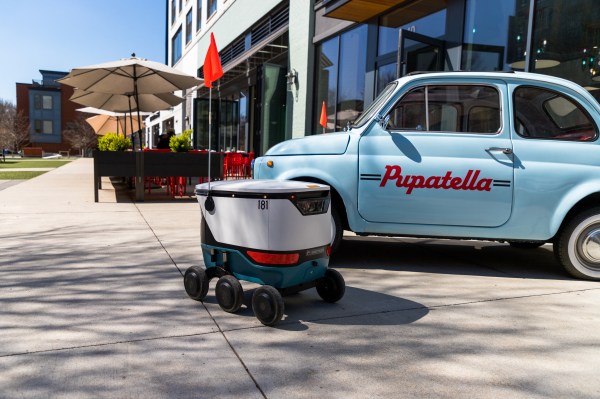Uber is expanding its partnership with sidewalk delivery robot startup Cartken to Fairfax, Virginia.
Starting Thursday, Uber Eats customers around the Mosaic District can choose to have food from select merchants delivered via one of Cartken’s small, six-wheeled, autonomous bots.
This is the second city where Uber and Cartken are partnering for commercial deliveries. The companies first launched a pilot in Miami in December, which is ongoing.
The Mosaic District is a shopping and dining center, and the bots will deliver food from restaurants to homes and businesses “in an around” the district, according to an Uber spokesperson. Uber did not specify what the delivery radius would be, but the district is about 31 acres, or 0.5 square miles, according to the Fairfax County Department of Planning and Development.
Cartken’s robots are electric and have a cargo capacity of around 1.5 cubic feet, or about two paper grocery bags. The robots have a number of cameras used to identify objects and help them reach their destination. Cartken has said before that its robots operate fully autonomously under certain conditions. If the bot meets something it hasn’t yet encountered, it can reach out to a remote operator for assistance.
Aside from its partnership with Uber, Cartken has also linked up with Grubhub to bring bots to college campuses like Ohio State University. Sidewalk delivery robots are becoming increasingly common on college campuses, where the neatly lined pavements and closed environment make for a safe place to test autonomous tech.
That’s also likely why the Mosaic District also makes for an attractive location for Uber and Cartken to launch their latest partnership.
At launch, merchants like Our Mom Eugenia, Pupatella and RASA will participate in the program. Image Credits: Uber
The companies wouldn’t share the size of Cartken’s fleet to be deployed, but Uber said it can be scaled to match customer demand. A spokesperson also told TechCrunch the robots can operate in all types of weather, even snow or rain. The spokesperson declined to provide exact hours that the bots will operate, but did say customers would be able to access them for lunch and dinner orders.
From the customer’s perspective while ordering, nothing will change much. The customer will still pay the merchant for the cost of food, and may also pay a delivery charge to Uber. If a customer adds a tip, however, they’ll receive a refund on that tip.
When the order is delivered, the customer will have to meet the bot outside and Uber will provide instructions for how to access their order.
Uber has been increasingly adding to its autonomous vehicle pilot portfolio in recent years. Last May, the company began a pilot in Los Angeles to deliver food via Serve Robotic’s autonomous sidewalk robots and Motional’s self-driving cars. At the end of last year, Uber and Motional also launched a robotaxi service in Las Vegas, part of the companies’ 10-year plan to co-scale across major North American cities.
